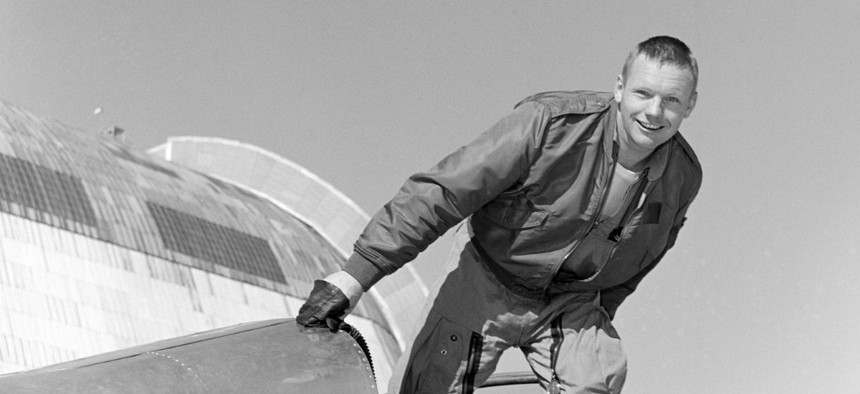
The real first man: Neil Armstrong emerges from the Ames Bell X-14 aircraft at NASA's Ames Research Center. Armstrong was the first man to walk on the moon. NASA
The Lesson for Federal Leaders in ‘First Man’
NASA found the right man to be the first man because it understood the moon landing was as much a people problem as an engineering challenge.
My wife and I recently saw “First Man,” Damien Chazelle’s stirring portrait of Neil Armstrong and his rocket ride to the moon. It’s an unparalleled adventure tale and a character study of one man’s struggle to balance ambition with family.
It’s also a fascinating story of public policy. President John F. Kennedy, the movie reminds us, had promised to put a man on the moon by the end of the 1960s. The Russians kept beating the United States to important milestones along the way. Disaster struck the crew of the first American moonship, taking the lives of three astronauts in a conflagration during a ground test. NASA was staring down the calendar as it faced unprecedented challenges to fulfill Kennedy’s promise.
Unlike most other space movies, “First Man” provides an unvarnished look at just how dangerous the journey was. The moon program struggled with known unknowns, including just what the surface of the moon would feel like. And it abounded with unknown unknowns, including what technical challenges might come out of nowhere and force the astronauts to make super-fast decisions to save their mission—and their lives.
Just what kind of man (the astronauts were all men in those days) should NASA choose for the first man? A test pilot with lots of experience in the air, or an engineer who understood the intricacies of the ship? A super-sharp astronaut with deft fingers or a we’ll-work-this-out problem-solver? NASA had no lack of candidates. In the end, to command the first landing, the agency chose Neil Armstrong, a civilian who had military combat experience, an astronaut in the Gemini program who used some of his reentry control fuel to stabilize his craft when the nation’s first docking maneuver in space led to near-disaster, an experimenter whose flight in a lunar lander simulator led to a fiery crash, which he barely survived thanks to his ejector seat.
In short, NASA concluded he was the right man to be the first man because he had conquered a host of unknown unknowns, with the patience of an engineer and the instincts of a pilot. The movie is a study of how one agency figured out what human capital skills it needed to accomplish its mission—and how to find the government employee whose individual capacity matched the need.
The choice proved an exceptionally smart one, especially in the face of an enormous challenge that almost slips by in the drama of the lunar landing. As Armstrong and his colleague Buzz Aldrin were in descent, alarms went off in their lunar lander, including a “1202” alarm that no one understood (it turned out that the computer was getting more information than it could handle). Communications with NASA were spotty, the radar wasn’t reliable, the surface didn’t look as smooth as the models had predicted, they were overshooting their planned landing spot, and their engines were kicking up so much dust they couldn’t see how close they were to the surface. Armstrong and Aldrin made it safely to the moon, at an unplanned site, with alarms buzzing in their ears, just seconds before their fuel ran out.
It happened because NASA had chosen the right man as the first man. Not everything has the drama of a moon landing or of a movie starring Ryan Gosling and Claire Foy. But there’s a bigger lesson here.
As we argued in our National Academy of Public Administration report, “No Time to Wait—Part 2,” there’s an urgent need to refashion government’s human capital—to shift from a culture of compliance to one of performance, by moving from a personnel system based on filling jobs to one built on individual competencies. That, of course, is just what NASA did in identifying the first man.
Doing that requires agency managers to know the skills they need and to find the employees who have them. It requires agency-based flexibility. But the evidence is that most agencies don’t use the flexibilities they already have. Some large agencies don’t even know what flexibilities they’ve got. Faced with so much uncertainty, many agencies have simply ripped the cover off old, outdated regulations and adopted them as their own. Using what’s familiar, even if it’s broken, is often easier than journeying into the unknown.
That’s especially true because there are very few agency-pathfinders out there—agencies that have effectively used the flexibilities they have to match their missions with employees who have the right stuff. It’s hard to be the first to break the bonds of existing rules, and it’s even more challenging when there are few models to follow.
So here’s an idea. The federal government needs a few agencies who bravely dare to go where no one has gone before: to develop a mission-based personnel system, uprooted from the existing rule-based processes and focused squarely on building capacity in individual employees—and then matching those employees’ skills with the job to be done. The federal government needs to look for agency-volunteers, to license their experimentation, to hold the volunteers accountable for results, and to not punish them for trying what’s never been done.
That, of course, is a tall order. But that’s how NASA and Neil Armstrong got to the moon. Space exploration isn’t for sissies. Neither is updating the federal government’s human capital system.
The difference? Despite Kennedy’s pledge, we really didn’t have to go to the moon. But we now have no choice but to update the human capital system. Too much of what we count on government to do requires finding the right men and women for the job, and we’re not doing a very good job of that now.
NASA proved it could find the right man to be the first man because the agency understood that it needed first to see the moon landing as a people problem, not just an engineering challenge. It’s time for a few other agencies to step forward to prove the same thing for government’s core functions.







